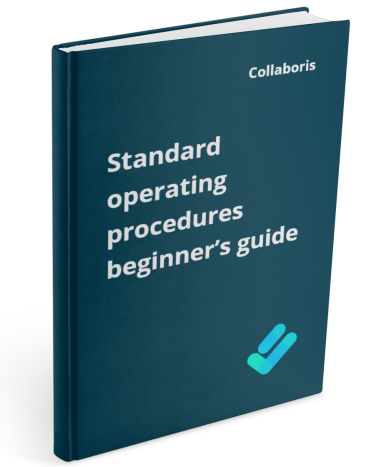Best Practices for Policy Change Management in SharePoint Managing policy documents efficiently is crucial ...
Differences between Process, Procedures and Policies

Processes, procedures and policies are the guidelines that a company follows to make sure they are operating in a way that is both effective and safe. Every business needs them, however, sometimes it can be confusing as to where one starts and another ends. Often businesses muddle up their use or refer to the wrong one when really meaning another.
At a high-level Processes, Procedures and Policies are best defined as:
Get your free Standard Operating Procedures guide
Creating Standard Operating Procedures for your organisation doesn't have to be complicated. This guide will introduce you to the whole lifecycle from creation to training and distribution.
What are the differences between a policy, process and procedure?
Policy
A policy is a formal rule, requirement or guideline that explains the company standards that must be followed. Policies should always be consistent with the companies strategic goals and uphold corporate values. They are often set at the highest levels within the organization to ensure corporate ideals are followed.
The policy itself should include information about what it is about, why it is needed and who is responsible for it. Responsibility for a policy includes making sure everyone who needs to know about it is informed and also adheres to it.
Process
A process details the steps of tasks that need to be completed in order to accomplish something. They can relate to the creation of a product, provision of a service or completion of a project for example. Processes should adhere to the companies rules and goals (so follow the companies policies) and give a high level view of the entire workflow.
The process should include details of who is responsible for completing it, the tasks that should be performed and also when they should be completed.
Procedure
A procedure is the most detailed of the three. It should include step by step instructions on how to perform a specific task. A single process may need to be supported by several procedures each explaining a different step within the process. Ideally, a procedure should be written in such a way that anyone could follow it.
The procedure should describe the steps that need to be completed and also detail how and when they should be done. A well written procedure should allow someone who had never completed the task before to successfully follow the instructions.
Examples for HR
A HR Policy may be written to ensure equal opportunities during the recruitment process. This may stipulate that no one can be discriminated against based on their gender, race, religious beliefs, nationality or other criteria for example.
The HR Process may detail how and where the job will be advertised and how the shortlisting and selection process should be managed.
The Procedure for pre-appointment checks may provide a list of items that must specifically be completed before a formal job offer is made. This may include checking the starting salary, gaining formal approval, completing interviews etc.
You may also like this post: 17 HR Policies every organization should have - Collaboris
Examples for Healthcare
A Healthcare Policy may be written to ensure that only fully trained or qualified healthcare professionals can administer medication.
The Medication Administration Process may detail how medication is stored and how, when, and by whom medication may be administered.
A Procedure for administering drugs for a residential patient should include clear instructions to ensure the correct medication is given to the correct patient. and how to record and chart the medication given.
Get your free policy template
Conclusion
Processes, Procedures and Policies are all essential business tools, and, when used appropriately can help the organization run efficiently.
Creating them may take a considerable amount of time and other resources in the first instance, but in the long run the benefits they can offer can pay dividends!
We have been developing policy compliance solutions for SharePoint for over 12 years.
We understand how difficult it is to ensure all employees have acknowledged critical documents like policies or procedures.
That's why we created DocRead, a tool that allows you to distribute policies, procedures, and important documents to employees and track acknowledgments, ensuring employee compliance and accountability.
All without leaving SharePoint.
DocRead has enabled us to see a massive efficiency improvement... we are now saving 2 to 3 weeks per policy on administration alone.
Nick Ferguson
Peregrine Pharmaceuticals
Feedback for the on-premises version of DocRead.
Benefits you can expect
Compliance and accountability
Set recurring assignments to ensure critical policies are read and acknowledged at regular intervals
Track progress and completion
The DocRead Compliance Cockpit summarizes the reading statuses of all assignments across the organization so Compliance Administrators can quickly get the complete picture
Fully integrated with SharePoint
DocRead seamlessly integrates with SharePoint content, without changing your documents or metadata
You may also like:
The Importance of Employee Knowledge Management In today's fast-paced business environment, knowledge is a ...
Essential Tips for Effective Policy ManagementIn today's fast-paced business environment, effective policy management is ...
Common problems organizations have with SOP's (and their solutions) Standard Operating Procedures (SOPs) are ...
10 Steps for Implementing Successful SOPs with SharePointStandard Operation procedures (SOPs) are key in ...
Manage Policies and Procedures in SharePoint No matter what size your organization, at some ...

